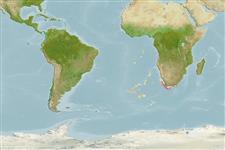Holocéphales (chimères) (chimaeras) >
Chimaeriformes (Chimaeras) >
Chimaeridae (Shortnose chimaeras or ratfishes)
Etymology: Chimaera: Named for the mythological creature composed of parts of multiple animals, referring to their odd mix of characteristics (See ETYFish); notafricana: notos (Gr.), south, referring to its known distribution off the western and southern coasts of southern Africa (See ETYFish).
Environment: milieu / climate zone / depth range / distribution range
Écologie
marin bathydémersal; profondeur 680 - 1000 m (Ref. 84536). Deep-water
Southeast Atlantic: from off Lüderitz, Namibia, around the Cape of Good Hope and eastwards to Algoa Bay, Eastern Cape Province, South Africa.
Taille / Poids / Âge
Maturity: Lm ? range ? - ? cm
Max length : 83.7 cm TL mâle / non sexé; (Ref. 84536); 93.0 cm TL (female)
Description synthétique
Clés d'identification | Morphologie | Morphométrie
This species was assigned to the genus Chimaera based on the presence of an anal fin which is separate from the ventral caudal margin by a notch. It is distinguished from its congeners by a set of characters: uniform blackish brown color with dark bluish streaking and precaudal tail with longitudinal light and dark stripes; dorsal spine when depressed reaches beyond origin of second dorsal fin; large triangular pectoral fins, when depressed reaches just to pelvic-fin origin; caudal fin ventral margin ending very slightly posterior to caudal fin dorsal margin insertion; males with short pelvic claspers that are externally trifid, 12.1-12.3% BDL, not extending past distal tip of pelvic fins, divided for distal one-third of length; distance from anterior base of dorsal fin spine to center of supratemporal canal short, 6.5-14.8% HDL (Ref. 84536).
Life cycle and mating behavior
Maturité | Reproduction | Frai | Œufs | Fécondité | Larves
Kemper, J.M., D.A. Ebert, L.J.V. Compagno and D.A. Didier, 2010. Chimaera notafricana sp. nov. (Chondrichthyes: Chimaeriformes: Chimaeridae), a new species of chimaera from southern Africa. Zootaxa 2532:55-63. (Ref. 84536)
Statut dans la liste rouge de l'IUCN (Ref. 130435: Version 2024-2)
Menace pour l'homme
Harmless
Utilisations par l'homme
Outils
Articles particuliers
Télécharger en XML
Sources Internet
Estimates based on models
Preferred temperature (Ref.
123201): 3.9 - 8, mean 4.2 °C (based on 5 cells).
Phylogenetic diversity index (Ref.
82804): PD
50 = 0.5000 [Uniqueness, from 0.5 = low to 2.0 = high].
Bayesian length-weight: a=0.00331 (0.00137 - 0.00798), b=3.07 (2.86 - 3.28), in cm total length, based on LWR estimates for this (Sub)family-body shape (Ref.
93245).
Niveau trophique (Ref.
69278): 3.7 ±0.6 se; based on size and trophs of closest relatives
Résilience (Ref.
120179): Faible, temps minimum de doublement de population : 4,5 à 14 années (Deepwater species with few large eggs.).
Fishing Vulnerability (Ref.
59153): High vulnerability (57 of 100).
